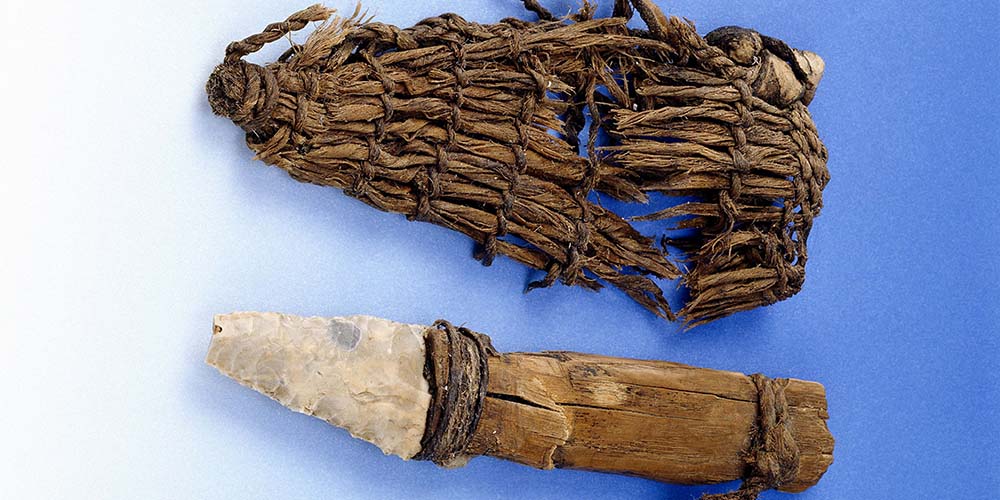Ötzi the Iceman, who lived over 5,200 years ago, was discovered with an impressive set of tools, including a dagger that is the only fully preserved example from the Copper Age. This small yet highly functional tool reveals much about the craftsmanship and survival skills of ancient people, offering us a fascinating window into the past.
The Design of the Dagger
Ötzi’s dagger measures 13 cm in length and features a flint blade securely attached to an ash wood handle. The flint blade was driven into the wooden handle and then bound tightly with animal sinew to ensure it remained fixed. A string was also attached to the end of the handle, perhaps to help secure the dagger or make it easier to carry. Despite its age, the dagger was designed with practicality and efficiency in mind, showing the advanced skills of its maker.

The Wicker Sheath
Accompanying the dagger was a 12 cm sheath, woven from lime tree bast, which served as both protection and storage. A leather eyelet on the side of the sheath likely allowed it to be fastened to a belt or another part of Ötzi’s clothing. Interestingly, the sheath is significantly larger than the dagger blade, which might seem odd at first glance. However, this suggests that the blade was frequently resharpened, gradually wearing it down to its small size—almost the same as an arrowhead.
The Flint: A Clue to Ötzi’s World
Modern tests have revealed that the flint used for Ötzi’s dagger came from Trentino, Italy, which is hundreds of kilometers away from where Ötzi’s body was discovered. This discovery opens up questions about the connections and trade routes that might have existed during the Copper Age. It’s a testament to the mobility of ancient people and the possible exchange of materials across different regions.
Sharpening Techniques
To maintain the sharpness of his flint blade, Ötzi used a retoucheur, a tool specifically designed to remove tiny fragments of stone, keeping the blade functional. This attention to maintenance shows that Ötzi not only used his tools but also possessed the skills to care for them, ensuring their longevity. The dagger was not a disposable item but rather a crucial tool that required constant upkeep, reflecting the harsh realities of survival during that era.
Analysis: The Significance of Ötzi’s Dagger
Ötzi’s dagger is more than just an ancient weapon; it is a symbol of the ingenuity and practical intelligence of early humans. The dagger’s compact size might seem underwhelming, but it was crafted for efficiency, indicating that even in ancient times, people were concerned with the durability and functionality of their tools.
The fact that the blade was repeatedly resharpened suggests that Ötzi valued this tool highly. In a world where survival was a daily challenge, every item had to serve multiple purposes. A small blade could be used for cutting, hunting, or even defense, making it an essential part of Ötzi’s everyday life. The attachment to a belt through the sheath’s leather eyelet also hints at the importance of keeping such a tool close at hand.
A Window into Copper Age Society
What’s even more remarkable is how the dagger reflects the larger societal structures of the time. The flint from Trentino shows that there may have been long-distance trade routes or exchanges between different groups, implying that Ötzi’s society was not isolated. Even small details like the type of wood used for the handle or the lime tree bast for the sheath suggest a deep knowledge of local materials and their best applications.
Lessons from the Past
Ötzi’s dagger invites us to consider the complexities of ancient life. While modern technology has advanced far beyond flint blades, this small tool reminds us that our ancestors had their own forms of innovation and craftsmanship. In many ways, their ingenuity was in making the most of the materials and resources available to them.
As we admire this ancient relic, we are prompted to think about how human curiosity and resourcefulness are timeless traits. Even in a world where survival often depended on such small yet crucial tools, ancient people were able to adapt and thrive. Ötzi’s dagger not only speaks to his individual story but also serves as a testament to the resilience and inventiveness of early human societies.
Conclusion: A Timeless Artifact
Ötzi’s 5,200-year-old dagger stands as a lasting symbol of the resourcefulness and craftsmanship of the Copper Age. Though small, its design and functionality reveal a great deal about the daily lives of ancient people. This remarkable artifact continues to fascinate researchers and history enthusiasts alike, reminding us that even in the distant past, humans were capable of creating tools that were as efficient as they were essential to survival.
What other secrets might this ancient tool hold, and how does it challenge our understanding of early human ingenuity? As we continue to study such artifacts, we are reminded that the past is not so distant after all.

